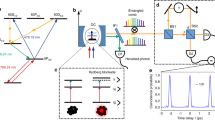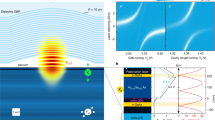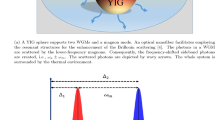Abstract
To create and manipulate non-classical states of light for quantum information protocols, a strong, nonlinear interaction at the single-photon level is required. One approach to the generation of suitable interactions is to couple photons to atoms, as in the strong coupling regime of cavity quantum electrodynamic systems1,2. In these systems, however, the quantum state of the light is only indirectly controlled by manipulating the atoms3. A direct photon–photon interaction occurs in so-called Kerr media, which typically induce only weak nonlinearity at the cost of significant loss. So far, it has not been possible to reach the single-photon Kerr regime, in which the interaction strength between individual photons exceeds the loss rate. Here, using a three-dimensional circuit quantum electrodynamic architecture4, we engineer an artificial Kerr medium that enters this regime and allows the observation of new quantum effects. We realize a gedanken experiment5 in which the collapse and revival of a coherent state can be observed. This time evolution is a consequence of the quantization of the light field in the cavity and the nonlinear interaction between individual photons. During the evolution, non-classical superpositions of coherent states (that is, multi-component ‘Schrödinger cat’ states) are formed. We visualize this evolution by measuring the Husimi Q function and confirm the non-classical properties of these transient states by cavity state tomography. The ability to create and manipulate superpositions of coherent states in such a high-quality-factor photon mode opens perspectives for combining the physics of continuous variables6 with superconducting circuits. The single-photon Kerr effect could be used in quantum non-demolition measurement of photons7, single-photon generation8, autonomous quantum feedback schemes9 and quantum logic operations10.
This is a preview of subscription content, access via your institution
Access options
Subscribe to this journal
Receive 51 print issues and online access
$199.00 per year
only $3.90 per issue
Buy this article
- Purchase on Springer Link
- Instant access to full article PDF
Prices may be subject to local taxes which are calculated during checkout




Similar content being viewed by others
References
Wallraff, A. et al. Strong coupling of a single photon to a superconducting qubit using circuit quantum electrodynamics. Nature 431, 162–167 (2004)
Haroche, S. & Raimond, J. M. Exploring the Quantum: Atoms, Cavities, And Photons (Oxford Univ. Press, 2006)
Hofheinz, M. et al. Synthesizing arbitrary quantum states in a superconducting resonator. Nature 459, 546–549 (2009)
Paik, H. et al. Observation of high coherence in Josephson junction qubits measured in a three-dimensional circuit QED architecture. Phys. Rev. Lett. 107, 240501 (2011)
Yurke, B. & Stoler, D. The dynamic generation of Schrodinger cats and their detection. Physica B+C 151, 298–301 (1988)
Braunstein, S. L. Quantum information with continuous variables. Rev. Mod. Phys. 77, 513–577 (2005)
Grangier, P., Levenson, J. & Poizat, J. Quantum non-demolition measurements in optics. Nature 396, 537–542 (1998)
Peyronel, T. et al. Quantum nonlinear optics with single photons enabled by strongly interacting atoms. Nature 488, 57–60 (2012)
Kerckhoff, J., Nurdin, H., Pavlichin, D. S. & Mabuchi, H. Designing quantum memories with embedded control: photonic circuits for autonomous quantum error correction. Phys. Rev. Lett. 105, 040502 (2010)
Milburn, G. Quantum optical Fredkin gate. Phys. Rev. Lett. 62, 2124–2127 (1989)
Saleh, B. E. A. & Teich, M. C. Fundamentals of Photonics (Wiley Series in Pure and Applied Optics, 1991)
Slusher, R. E., Hollberg, L., Yurke, B., Mertz, J. & Valley, J. Observation of squeezed states generated by four-wave mixing in an optical cavity. Phys. Rev. Lett. 55, 2409–2412 (1985)
Franken, P., Hill, A., Peters, C. & Weinreich, G. Generation of optical harmonics. Phys. Rev. Lett. 7, 118–119 (1961)
Fisher, R. A., Kelley, P. L. & Gustafson, T. K. Subpicosecond pulse generation using the optical Kerr effect. Appl. Phys. Lett. 14, 140–143 (1969)
Nigg, S. E. et al. Black-box superconducting circuit quantization. Phys. Rev. Lett. 108, 240502 (2012)
Bourassa, J., Beaudoin, F., Gambetta, J. M. & Blais, A. Josephson-junction-embedded transmissionline resonators: from Kerr medium to in-line transmon. Phys. Rev. A 86, 013814 (2012)
Bergeal, N. et al. Phase-preserving amplification near the quantum limit with a Josephson ring modulator. Nature 465, 64–68 (2010)
Yurke, B. et al. Observation of 4.2-K equilibrium-noise squeezing via a Josephson-parametric amplifier. Phys. Rev. Lett. 60, 764–767 (1988)
Yin, Y. et al. Dynamic quantum Kerr effect in circuit quantum electrodynamics. Phys. Rev. A 85, 023826 (2012)
Hoffman, A. et al. Dispersive photon blockade in a superconducting circuit. Phys. Rev. Lett. 107, 053602 (2011)
Shalibo, Y. et al. Direct Wigner tomography of a superconducting anharmonic oscillator. Preprint at http://arXiv.org/abs/1208.2441 (2012)
Meekhof, D. M., Monroe, C., King, B. E., Itano, W. M. & Wineland, D. J. Generation of nonclassical motional states of a trapped atom. Phys. Rev. Lett. 76, 1796–1799 (1996)
Greiner, M., Mandel, O., Hänsch, T. W. & Bloch, I. Collapse and revival of the matter wave field of a Bose-Einstein condensate. Nature 419, 51–54 (2002)
Johnson, B. R. et al. Quantum non-demolition detection of single microwave photons in a circuit. Nature Phys. 6, 663–667 (2010)
Solano, E. Selective interactions in trapped ions: state reconstruction and quantum logic. Phys. Rev. A 71, 013813 (2005)
Milburn, G. Quantum and classical Liouville dynamics of the anharmonic-oscillator. Phys. Rev. A 33, 674–685 (1986)
Deléglise, S. et al. Reconstruction of non-classical cavity field states with snapshots of their decoherence. Nature 455, 510–514 (2008)
Eichler, C., Bozyigit, D. & Wallraff, A. Characterizing quantum microwave radiation and its entanglement with superconducting qubits using linear detectors. Phys. Rev. A 86, 032106 (2012)
Leibfried, D. et al. Experimental determination of the motional quantum state of a trapped atom. Phys. Rev. Lett. 77, 4281–4285 (1996)
Leghtas, Z. et al. Hardware-efficient autonomous quantum error correction. Preprint at http://arXiv.org/abs/1207.0679 (2012)
Acknowledgements
We thank M. H. Devoret, M. D. Reed, M. Hatridge and A. Sears for discussions. This research was supported by the National Science Foundation (NSF) (PHY-0969725), the Office of the Director of National Intelligence (ODNI), Intelligence Advanced Research Projects Activity (IARPA) through the Army Research Office (W911NF-09-1-0369), and the US Army Research Office (W911NF-09-1-0514). Use of facilities was supported by the Yale Institute for Nanoscience and Quantum Engineering (YINQE) and the NSF (MRSECDMR 1119826). S.M.G. acknowledges support from the NSF (DMR-1004406). M.M. and Z.L. acknowledge support from French Agence Nationale de la Recherche under the project EPOQ2 (ANR-09-JCJC-0070). S.E.N. acknowledges support from the Swiss NSF. E.G. acknowledges support from EPSRC (EP/I026231/1).
Author information
Authors and Affiliations
Contributions
G.K. and B.V. performed the experiments. G.K., B.V., Z.L. and M.M. analysed the data. G.K., B.V. and L.F. fabricated the qubits. G.K., B.V., H.P. and S.E.N. designed the device and calculated the device parameters. G.K., E.G., S.M.G. and R.J.S. conceived the experiment and all authors co-wrote the paper.
Corresponding author
Ethics declarations
Competing interests
The authors declare no competing financial interests.
Supplementary information
Supplementary Information
This file contains Supplementary Text and Data, Supplementary Figures 1-5 and Supplementary References. (PDF 1186 kb)
Evolution of the Q function of a coherent state in a Kerr medium
This video shows the evolution of the Q function of a coherent state in a Kerr medium. The left frame shows the measured data while the right frame shows a simulation, which was obtained by numerically solving a master equation for the same interaction times. The total evolution was measured over 6.05µs, showing two coherent state revivals. (MOV 17414 kb)
Rights and permissions
About this article
Cite this article
Kirchmair, G., Vlastakis, B., Leghtas, Z. et al. Observation of quantum state collapse and revival due to the single-photon Kerr effect. Nature 495, 205–209 (2013). https://doi.org/10.1038/nature11902
Received:
Accepted:
Published:
Issue Date:
DOI: https://doi.org/10.1038/nature11902
This article is cited by
-
Preparation of maximally-entangled states with multiple cat-state qutrits in circuit QED
Frontiers of Physics (2024)
-
Generation of a hybrid W entangled state of three photonic qubits with different encodings
Quantum Information Processing (2024)
-
Dynamical entropic measure of nonclassicality of phase-dependent family of Schrödinger cat states
Scientific Reports (2023)
-
Cloaking a qubit in a cavity
Nature Communications (2023)
-
Nonlinear nanomechanical resonators approaching the quantum ground state
Nature Physics (2023)
Comments
By submitting a comment you agree to abide by our Terms and Community Guidelines. If you find something abusive or that does not comply with our terms or guidelines please flag it as inappropriate.



